
The Heart of Vatican City: St. Peter's Square
Explore the grandeur of St. Peter's Square in Vatican City, a stunning Baroque masterpiece and religious epicenter featuring St. Peter's Basilica and the Vatican Museums.
St. Peter's Square, located in the heart of Vatican City, is a must-see destination for tourists from around the world. Designed by Gian Lorenzo Bernini in the 17th century, the square is a stunning example of Baroque architecture. It is surrounded by majestic colonnades and features the magnificent St. Peter's Basilica as its centerpiece. The square is not only a religious site but also a place of historical and cultural significance. Visitors to St. Peter's Square can marvel at the grandeur of the basilica, which is one of the largest churches in the world. The interior of the basilica is adorned with beautiful mosaics, sculptures, and paintings, including Michelangelo's famous Pietà. The dome of the basilica offers breathtaking views of Vatican City and Rome, making it worth the climb. The square itself is a lively place, filled with pilgrims, tourists, and locals. It often hosts important events and papal audiences, adding to its vibrant atmosphere. At the center of the square stands an ancient Egyptian obelisk, flanked by two impressive fountains. St. Peter's Square is also home to the Vatican Museums, where visitors can explore a vast collection of art and artifacts, including the Sistine Chapel with its iconic ceiling painted by Michelangelo.
Local tips in St. Peter's Square
- Arrive early in the morning to avoid long lines and large crowds.
- Dress modestly, as there is a strict dress code for entering St. Peter's Basilica.
- Consider taking a guided tour to fully appreciate the history and art.
- Check the Vatican's schedule for papal audiences and special events.
- Climb to the top of the basilica's dome for panoramic views of Rome.
- Purchase tickets to the Vatican Museums online in advance to skip the lines.
The Heart of Vatican City: St. Peter's Square
St. Peter's Square, located in the heart of Vatican City, is a must-see destination for tourists from around the world. Designed by Gian Lorenzo Bernini in the 17th century, the square is a stunning example of Baroque architecture. It is surrounded by majestic colonnades and features the magnificent St. Peter's Basilica as its centerpiece. The square is not only a religious site but also a place of historical and cultural significance. Visitors to St. Peter's Square can marvel at the grandeur of the basilica, which is one of the largest churches in the world. The interior of the basilica is adorned with beautiful mosaics, sculptures, and paintings, including Michelangelo's famous Pietà. The dome of the basilica offers breathtaking views of Vatican City and Rome, making it worth the climb. The square itself is a lively place, filled with pilgrims, tourists, and locals. It often hosts important events and papal audiences, adding to its vibrant atmosphere. At the center of the square stands an ancient Egyptian obelisk, flanked by two impressive fountains. St. Peter's Square is also home to the Vatican Museums, where visitors can explore a vast collection of art and artifacts, including the Sistine Chapel with its iconic ceiling painted by Michelangelo.
When is the best time to go to St. Peter's Square?
Iconic landmarks you can’t miss
Vatican Museums
Explore the Vatican Museums, a stunning collection of art and history in the heart of Vatican City, featuring masterpieces by Michelangelo and Raphael.

St. Peter's Basilica
Explore St. Peter's Basilica, a stunning masterpiece of Renaissance architecture and a spiritual haven in Vatican City, attracting millions of visitors each year.

Sistine Chapel
Discover the artistic splendor of the Sistine Chapel, where Michelangelo's masterpieces and rich history converge in Vatican City.

Saint Peter's Square
Discover the breathtaking beauty and spiritual essence of Saint Peter's Square, a historic landmark in Vatican City that welcomes millions of visitors each year.
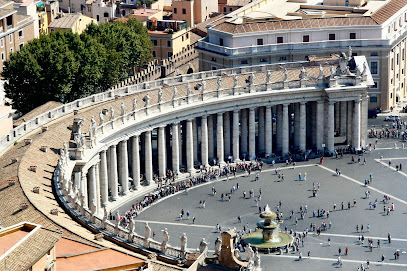
St. Peter Square Obelisk
Discover the awe-inspiring St. Peter Square Obelisk, a historical landmark that embodies the rich heritage of Vatican City.

Gardens of Vatican City
Discover the enchanting Gardens of Vatican City, a tranquil haven filled with history, art, and stunning landscapes in the heart of Rome.

Chiesa di Sant'Anna dei Palafrenieri
Explore the serene Chiesa di Sant'Anna dei Palafrenieri, a hidden gem in Vatican City, where stunning architecture meets tranquil spirituality.

Apostolic Palace
Discover the Apostolic Palace, a historical landmark and the Pope's residence in Vatican City, filled with art, culture, and spiritual significance.

Vatican Necropolis
Explore the Vatican Necropolis, an ancient burial site beneath St. Peter's Basilica, and uncover the secrets of early Christianity in Rome.

Pine Courtyard
Explore the tranquil beauty of the Pine Courtyard in Vatican City, a serene garden oasis blending nature and history, perfect for a peaceful retreat.
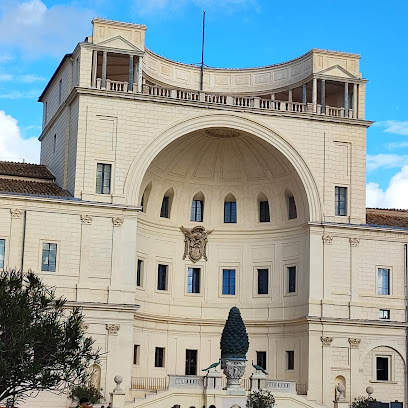
La Pietà di Michelangelo
Discover the emotional depth of La Pietà di Michelangelo, a Renaissance masterpiece that embodies grace and faith in the heart of Vatican City.

Excavation Office
Explore the Excavation Office of the Vatican and discover the hidden treasures beneath St. Peter's Basilica, where history and spirituality intertwine.

Arco dei Banchi
Explore the stunning Arco dei Banchi in Rome, a historical arch that captures the essence of Italian architecture and rich cultural heritage.

Gallery of Maps
Explore the Gallery of Maps in Vatican City, where art and history blend beautifully through stunning Renaissance frescoes and intricate cartography.

Tomb of Saint Peter
Explore the Tomb of Saint Peter in Vatican City, a spiritual cornerstone and pilgrimage site rich in history and reverence.

Unmissable attractions to see
Trevi Fountain
Discover the magic of the Trevi Fountain, a stunning baroque masterpiece and a must-visit historical landmark in the heart of Rome.

Pantheon
Explore the Pantheon, Rome's architectural gem, an ancient monument that embodies the grandeur of Roman civilization and its timeless beauty.

Piazza Navona
Discover the charm of Piazza Navona, a historical square in Rome adorned with stunning fountains, vibrant street life, and rich cultural heritage.

Vatican Museums
Discover the artistic marvels and historical treasures of the Vatican Museums, a cultural gem in the heart of Vatican City.

St. Peter's Basilica
Explore the grandeur of St. Peter's Basilica, a masterpiece of Renaissance architecture and a spiritual haven in Vatican City.
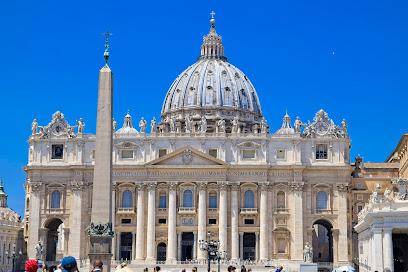
Roman Forum
Discover the ancient heart of Rome at the Roman Forum, an open-air museum showcasing the ruins of a civilization that shaped history.

Castel Sant'Angelo
Explore the rich history and stunning views of Castel Sant'Angelo, a key historical landmark and museum in Rome.

Sistine Chapel
Explore the Sistine Chapel in Vatican City, a breathtaking blend of art and spirituality, featuring Michelangelo's iconic masterpieces.

Villa Borghese
Explore the lush landscapes, art treasures, and serene lakes of Villa Borghese, Rome's stunning park that blends nature and culture seamlessly.

Circus Maximus
Explore the grandeur of Circus Maximus, an ancient Roman stadium that brings history to life amidst stunning views and vibrant local culture.
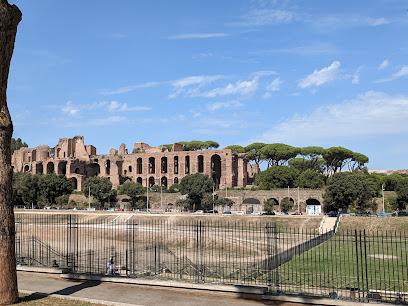
Papal Basilica of Saint Mary Major
Discover the awe-inspiring beauty of the Papal Basilica of Saint Mary Major, Rome's stunning masterpiece of faith, art, and history.

Largo di Torre Argentina
Explore the ancient ruins of Largo di Torre Argentina, where history, architecture, and a unique cat sanctuary coexist in the heart of Rome.

Villa d'Este
Explore the breathtaking gardens and historical beauty of Villa d'Este, a UNESCO World Heritage site in Tivoli, Italy, renowned for its stunning fountains and architecture.

Stadio Olimpico
Discover the thrilling atmosphere of Stadio Olimpico, Rome's premier sports venue, where history meets excitement in the heart of the Eternal City.

Basilica of San Giovanni in Laterano
Explore the Basilica of San Giovanni in Laterano, a breathtaking blend of history, architecture, and spirituality in the heart of Rome.

Essential places to dine
Ristorante Pizzeria Castello
Discover authentic Roman cuisine at Ristorante Pizzeria Castello—famous for its wood-fired pizzas and fresh seafood in the heart of Rome.

Pastasciutta
Discover authentic Italian flavors at Pastasciutta in Rome - where fresh pasta meets fast-casual dining for an unforgettable culinary experience.

Ristorante dei Musei
Experience authentic Italian flavors at Ristorante dei Musei, where delectable pizzas meet warm hospitality in the heart of Rome.

Borghiciana Pastificio Artigianale
Experience the heart of Roman cuisine at Borghiciana Pastificio Artigianale, where handmade pasta meets traditional flavors.

Pizza Zizza
Experience authentic Italian pizza at Pizza Zizza in Rome – where tradition meets flavor in every slice.

Sfiziami Italian Bistrot
Discover authentic Italian flavors at Sfiziami Italian Bistrot in Rome, where every bite transports you to culinary paradise.

Ristorante Arlù
Experience authentic Italian cuisine at Ristorante Arlù in Rome – where every dish tells a story of tradition and flavor.

Bono Bottega Nostrana- San Pietro
Discover culinary delights at Bono Bottega Nostrana, Rome's premier sandwich shop offering gourmet flavors in a cozy atmosphere.

Satiricus Ristorante Pizzeria
Experience authentic Italian dining at Satiricus Ristorante Pizzeria - where every meal is a celebration of flavor and tradition.

Mama Eat Lab
Experience the best gluten-free Italian cuisine at Mama Eat Lab in Rome - where tradition meets dietary innovation.

Cafe Risorgimento
Discover authentic Roman flavors at Cafe Risorgimento, where exquisite coffee meets delightful Italian cuisine.

La Locanda di Pietro
Experience authentic Italian flavors at La Locanda di Pietro - your go-to restaurant in Rome for Mediterranean cuisine and delightful dining.

Scialla The Original Street Food
Discover authentic Roman street food at Scialla, where delicious pizzas and fine wines create an unforgettable dining experience in Rome.

EGG Pasta Fresca
Discover EGG Pasta Fresca in Rome: where authentic Italian pasta meets affordability and flavor in every bite.

Goose
Experience authentic Roman cuisine at Goose, where every dish tells a story and every meal is a celebration of Italy's culinary heritage.

Markets, malls and hidden boutiques
Annona Vatican City
Explore Annona Vatican City - your gateway to authentic Italian ingredients and local delicacies in the heart of Vatican City.

Libreria Ancora Store - Roma
Explore Rome's Libreria Ancora Store, a captivating bookstore offering a rich collection of literature, religious goods, and a unique cultural experience.

Savelli Religious (Savelli Art and Tradition)
Explore Savelli Religious in Rome, a unique destination for spiritual gifts, exquisite jewelry, and authentic Italian craftsmanship.

St. Peter's Gallery
Explore St. Peter's Gallery: A unique souvenir store and coffee shop near the Vatican, offering local crafts and a cozy atmosphere.

Mondo Cattolico
Discover a unique collection of religious artifacts and souvenirs at Mondo Cattolico in Vatican City, the spiritual heart of Rome.

Vatican Emporium - Religious Articles & Gifts
Explore a unique collection of religious artifacts at Vatican Emporium, the premier destination for sacred gifts in the heart of Rome.

Domus Artis
Discover the artistic heart of Rome at Domus Artis, where unique art, jewelry, and souvenirs celebrate Italy's rich cultural heritage.

Massi Souvenir
Explore Massi Souvenir in Rome for unique Italian gifts and keepsakes that embody the essence of Italian craftsmanship.

Tourist Information Office
Discover the Vatican Tourist Information Office for exclusive souvenirs and expert travel advice in the heart of Vatican City.

Galleria Mariana
Discover Galleria Mariana in Rome for an authentic selection of religious goods and spiritual artifacts that embody Italy's rich cultural heritage.

Souvenirs San Pietro Sas di Ferru Zenobio E C.
Discover unique religious treasures and souvenirs in the heart of Rome at Souvenirs San Pietro, just steps from St. Peter's Basilica.

Mango Arredi Sacri
Discover the artistry of Italian jewelry at Mango Arredi Sacri, a charming gem in the heart of Rome, perfect for souvenirs and gifts.

Porta Angelica Srl
Explore Porta Angelica Srl, the ultimate destination for authentic religious artifacts and unique gifts near the Vatican in Rome.

Emporio Vaticano
Explore Emporio Vaticano for unique religious artifacts and souvenirs, capturing the spiritual essence of Rome's Vatican City.

HUMILIS Made in Assisi (Boutique Roma Vaticano)
Explore exquisite handcrafted jewelry at HUMILIS Made in Assisi, a unique boutique in Rome capturing the essence of Italian craftsmanship.

Essential bars & hidden hideouts
Be.Re. + Trapizzino
Discover the unique flavors of Rome at Be.Re. + Trapizzino, where street food meets culinary creativity in a vibrant gastropub setting.

Wine Bar De' Penitenzieri
Experience the heart of Italian wine culture at Wine Bar De' Penitenzieri, where every sip tells a story of tradition and passion.

Caffè Vaticano
Experience authentic Italian coffee culture at Caffè Vaticano, your perfect stop near the Vatican in the heart of Rome.

Cafe San Pietro
Experience authentic Italian coffee and pastries at Cafe San Pietro, just steps away from St. Peter's Basilica in Rome.
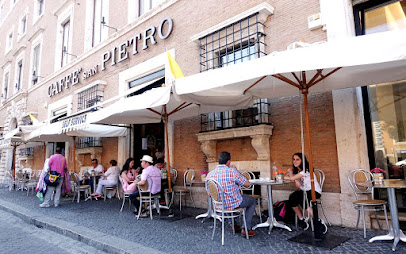
Bukowski's Bar
Experience authentic Italian flavors and a cozy ambiance at Bukowski's Bar, a charming bistro in the heart of Rome.

The Basement - Pub. Cocktail Bar. Events
Experience the vibrant nightlife of Rome at The Basement, a top pub and cocktail bar in the heart of the Prati district.

Saxophone Live Pub
Experience vibrant nightlife at Saxophone Live Pub in Rome, where live jazz and an inviting atmosphere create unforgettable memories.
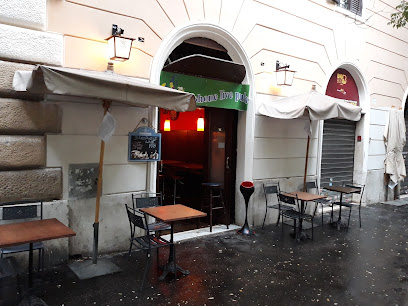
Birreria Martini Esperienza Tedesca
Discover the spirit of Germany in Rome at Birreria Martini, a lively beer hall serving authentic German cuisine and an impressive selection of beers.

Wine Bar All Brothers
Experience authentic Italian dining at Wine Bar All Brothers, featuring exquisite pizzas, local wines, and a delightful atmosphere in the heart of Rome.
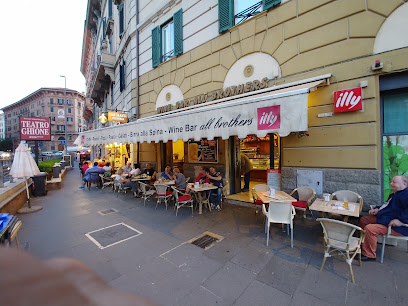
Ginny | Cocktail Bar | Wine Bar | Ristorante
Experience the vibrant atmosphere of Ginny, Rome's premier cocktail and wine bar, where exquisite drinks and delicious cuisine await.
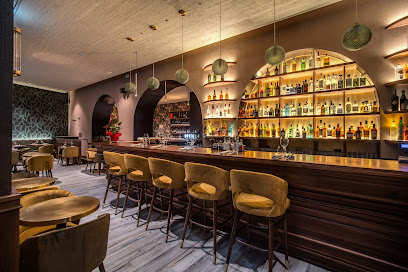
Bar Latteria Giuliani
Experience authentic Italian culture at Bar Latteria Giuliani, where delicious coffee meets a warm, inviting atmosphere in the heart of Rome.

Derry Rock Pub
Derry Rock Pub: A vibrant Irish pub in Rome offering cocktails, live music, and an unforgettable atmosphere for every tourist.

Caffè Leonina
Discover Caffè Leonina, a charming bar in Rome offering authentic Italian coffee and a cozy atmosphere for every traveler.

Roof Garden & Bar
Discover breathtaking views and exquisite cocktails at Rome's premier rooftop bar, the Roof Garden & Bar, an unforgettable experience in the heart of the Eternal City.

Bar Delle Grazie
Experience the authentic flavors of Italy at Bar Delle Grazie, a cozy bar in Rome known for its delicious coffee and pastries.

Travel experiences inspired by this city
Explore more travel diariesLocal Phrases
-
- HelloSalve
[SAHL-veh] - GoodbyeArrivederci
[ah-ree-veh-DEHR-chee] - YesSì
[SEE] - NoNo
[NOH] - Please/You're welcomePer favore/Prego
[pehr FAH-voh-reh/PRAY-goh] - Thank youGrazie
[GRAH-tsyeh] - Excuse me/SorryMi scusi/Scusa
[mee SKOO-zee/SKOO-zah] - How are you?Come stai?
[KOH-meh STAH-ee] - Fine. And you?Bene. E tu?
[BEH-neh. EH too?] - Do you speak English?Parli inglese?
[PAHR-lee een-GLEH-zeh] - I don't understandNon capisco
[nohn kah-PEES-koh]
- HelloSalve
-
- I'd like to see the menu, pleaseVorrei vedere il menù, per favore
[voh-RAY veh-DEH-reh eel meh-NOO pehr FAH-voh-reh] - I don't eat meatNon mangio carne
[nohn MAHN-joh KAR-neh] - Cheers!Salute!
[sah-LOO-teh] - I would like to pay, pleaseVorrei pagare, per favore
[voh-RAY pah-GAH-reh pehr FAH-voh-reh]
- I'd like to see the menu, pleaseVorrei vedere il menù, per favore
-
- Help!Aiuto!
[ai-OH-toh] - Go away!Vai via!
[vai VEE-ah] - Call the Police!Chiama la polizia!
[KYAH-mah lah poh-LEE-tsyah] - Call a doctor!Chiama un dottore!
[KYAH-mah oon doh-TOH-reh] - I'm lostMi sono perso
[mee SOH-noh PEHR-soh] - I'm illSto male
[stoh MAH-leh]
- Help!Aiuto!
-
- I'd like to buy...Vorrei comprare...
[voh-RAY kohm-PRAR-reh] - I'm just lookingSto solo guardando
[stoh SOH-loh gwar-DAHN-doh] - How much is it?Quanto costa?
[KWAHN-toh KOH-stah] - That's too expensiveÈ troppo caro
[eh TROH-poh KAH-roh] - Can you lower the price?Puoi abbassare il prezzo?
[PWEE ahb-bah-SAH-reh eel PREH-tsoh]
- I'd like to buy...Vorrei comprare...
-
- What time is it?Che ora è?
[keh OH-rah eh] - It's one o'clockÈ l'una in punto
[eh LOO-nah een POON-toh] - Half past (10)Le dieci e mezza
[leh DYEH-chee eh MEH-tzah] - MorningMattina
[maht-TEE-nah] - AfternoonPomeriggio
[poh-meh-REE-joh] - EveningSera
[SEH-rah] - YesterdayIeri
[YEH-ree] - TodayOggi
[OH-jee] - TomorrowDomani
[doh-MAH-nee] - 1Uno
[OO-noh] - 2Due
[DOO-eh] - 3Tre
[TREH] - 4Quattro
[KWAT-troh] - 5Cinque
[CHEEN-kweh] - 6Sei
[SAY] - 7Sette
[SEHT-teh] - 8Otto
[OH-ttoh] - 9Nove
[NOH-veh] - 10Dieci
[DYEH-chee]
- What time is it?Che ora è?
-
- Where's a/the...?Dov'è un/il...
[doh-VEH oon/eel] - What's the address?Qual è l'indirizzo?
[kwal eh leen-DEER-eet-zoh] - Can you show me (on the map)?Puoi mostrarmi (sulla mappa)?
[PWEE mohs-TRAHR-mee SOO-lah MAHP-pah] - When's the next (bus)?Quando passa il prossimo (autobus)?
[KWAHN-doh PAHS-sah eel PROHS-see-moh (ow-TOH-boos)] - A ticket (to ....)Un biglietto (per ....)
[oon beel-YET-toh (pehr)]
- Where's a/the...?Dov'è un/il...
History of St. Peter's Square
-
St. Peter's Square, or Piazza San Pietro, was designed by the renowned architect Gian Lorenzo Bernini between 1656 and 1667. The square was commissioned by Pope Alexander VII, who wanted a grand entrance to St. Peter's Basilica. Bernini's design features a large, open space surrounded by massive colonnades that symbolize the welcoming arms of the church.
-
At the center of St. Peter's Square stands a 25.5-meter-tall Egyptian obelisk made of red granite. This ancient structure was originally erected in Heliopolis, Egypt, and brought to Rome by Emperor Caligula in 37 AD. In 1586, Pope Sixtus V had it moved to its current location in the square. The obelisk serves as a sundial, with its shadow marking the hours on the ground.
-
The elliptical colonnades of St. Peter's Square consist of 284 Doric columns arranged in four rows. These colonnades create a grand, theatrical effect, leading visitors' eyes towards St. Peter's Basilica. The columns were designed to create a sense of movement and dynamism, emphasizing the spiritual journey towards the church.
-
St. Peter's Square is famously known for being a gathering place for Catholics around the world. The Pope often appears at the window of the Apostolic Palace to deliver blessings and messages to the crowd below. Notably, the Pope delivers the Urbi et Orbi blessing from the square on Christmas and Easter.
-
St. Peter's Square has been the site of many significant canonization ceremonies, where individuals are officially declared saints by the Catholic Church. These ceremonies draw thousands of pilgrims from around the world. One notable event was the canonization of Mother Teresa in 2016, attended by tens of thousands of faithful.
-
While the actual conclave to elect a new Pope takes place in the Sistine Chapel, St. Peter's Square plays a crucial role in this historic event. Crowds gather in the square, eagerly awaiting the appearance of white smoke from the Sistine Chapel's chimney, signaling the election of a new Pope. The new Pope then makes his first public appearance on the balcony of St. Peter's Basilica.
-
During World War II, St. Peter's Square remained a neutral zone, as Vatican City itself was considered neutral territory. The square served as a sanctuary for many refugees and those seeking safety from the conflict. Pope Pius XII played a significant role in providing aid and shelter to those affected by the war.
-
Jubilee years, or Holy Years, are special events in the Catholic Church that occur every 25 years. St. Peter's Square becomes a focal point during these celebrations, attracting millions of pilgrims who come to seek special indulgences. The square is adorned with special decorations, and various religious ceremonies and events take place throughout the Jubilee year.
-
Each year, St. Peter's Square hosts a large Christmas tree and an elaborate Nativity scene, attracting visitors from around the world. The tradition of the Vatican Christmas tree began in 1982 under Pope John Paul II. The Nativity scene often features life-sized figures and intricate details, becoming a central part of the Vatican's festive celebrations.
-
In contemporary times, St. Peter's Square continues to be a major destination for pilgrims and tourists alike. The square's historical and religious significance, coupled with its architectural grandeur, makes it a must-visit location for those exploring Vatican City. Guided tours often highlight the square's rich history and its role in the Catholic faith.
St. Peter's Square Essentials
-
St. Peter's Square is located in Vatican City, an independent city-state enclaved within Rome, Italy. The nearest airport is Leonardo da Vinci International Airport (Fiumicino), approximately 30 kilometers away. From the airport, you can take a train (Leonardo Express) to Roma Termini, then transfer to the metro (Line A) and get off at Ottaviano-San Pietro station. From there, it's a 10-minute walk to St. Peter's Square. Alternatively, taxis and shuttle services are also available from the airport.
-
Vatican City itself is very small and can be easily navigated on foot. Most visitors will stay in Rome and make day trips to the Vatican. Rome has an extensive public transportation system including buses, trams, and metro lines. The closest metro stations to St. Peter's Square are Ottaviano-San Pietro and Cipro on Line A. Buses 40 and 64 also run frequently to the Vatican area. Taxis are readily available but can be more expensive.
-
The official currency in Vatican City is the Euro (EUR). Credit and debit cards are widely accepted in most establishments, including museums and gift shops within the Vatican. However, it's advisable to carry some cash for small purchases or in case you visit local markets or cafes that may not accept cards. ATMs are available near St. Peter's Square and throughout Rome.
-
Vatican City is generally very safe for tourists. However, it is surrounded by some areas of Rome where pickpocketing and scams targeting tourists are common, especially around major tourist attractions and crowded places like Termini Station and bus stops. Always keep an eye on your belongings, avoid flashing valuables, and be cautious when approached by strangers offering unsolicited help or services.
-
In case of emergency while in Vatican City, dial 112 for immediate assistance, which is the emergency number for police, fire, and medical services throughout the EU. There is a medical station within Vatican City, but for serious emergencies, you may be taken to a hospital in Rome. It is highly recommended to have travel insurance that covers medical emergencies. Pharmacies are available in the vicinity for minor health issues.
-
Fashion: Do dress modestly when visiting St. Peter's Basilica and other religious sites. Shoulders and knees should be covered. Avoid wearing shorts, tank tops, and hats inside religious buildings. Religion: Do respect the religious nature of the Vatican. Maintain a quiet demeanor and avoid disruptive behavior. Public Transport: Do validate your ticket before boarding buses or trams. Fines for not having a validated ticket can be hefty. Don't eat or drink on public transport. Greetings: Do greet people with a polite 'Buongiorno' (Good morning) or 'Buonasera' (Good evening). Eating & Drinking: Do try local Roman dishes and enjoy leisurely meals. Don't rush through your meal; eating is a social activity in Italy.
-
For a more local experience, visit St. Peter's Square early in the morning before the crowds arrive. Attend the Papal Audience on Wednesdays or the Angelus on Sundays to see the Pope. Enjoy a gelato from a nearby gelateria and stroll around the surrounding neighborhoods such as Borgo Pio for a more authentic Roman experience. Take the time to explore the lesser-known Vatican Gardens, which require a guided tour booked in advance. Lastly, consider taking a guided tour to gain deeper insights into the history and significance of the Vatican.
Trending Landmark in St. Peter's Square
-
Vatican Museums
-
St. Peter's Basilica
-
Sistine Chapel
-
Saint Peter's Square
-
St. Peter Square Obelisk
-
Gardens of Vatican City
-
Chiesa di Sant'Anna dei Palafrenieri
-
Apostolic Palace
-
Vatican Necropolis
-
Pine Courtyard
-
La Pietà di Michelangelo
-
Excavation Office
-
Arco dei Banchi
-
Gallery of Maps
-
Tomb of Saint Peter
Nearby Cities to St. Peter's Square
-
Things To Do in Apostolic Palace
-
Things To Do in Sistine Chapel
-
Things To Do in St. Peter's Basilica
-
Things To Do in Vatican Necropolis
-
Things To Do in Gregorian Etruscan Museum
-
Things To Do in Vatican Pinacoteca
-
Things To Do in Vatican Museums
-
Things To Do in Vatican Gardens
-
Things To Do in Rome
-
Things To Do in Orvieto
-
Things To Do in Assisi
-
Things To Do in Perugia
-
Things To Do in Montepulciano
-
Things To Do in Arezzo
-
Things To Do in Siena












